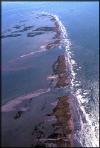About This Item
- Full text of this item is not available.
- Abstract PDFAbstract PDF(no subscription required)
Share This Item
The AAPG/Datapages Combined Publications Database
GCAGS Transactions
Abstract
Abstract: Tropical Cyclone and Winter Storm Impacts on the Short-Term Evolution of Barriers along the Northeastern Gulf of Mexico
Abstract
Recent data suggest that the north-central Gulf of Mexico coast has undergone an increase in the number of tropical cyclone landfalls over the past decade. Louisiana State University and the U.S. Geological Survey have monitored the Florida panhandle and Alabama coasts since the mid 1990s using airborne LIDAR and field surveys. The resultant data sets provide a unique time series capturing morphological change and post-storm adjustment due to three powerful events (Hurricanes Opal [1995], Ivan, [2004], and Katrina [2005]), weaker hurricanes and numerous tropical storms. In this paper we document a unique response of this coast to storm surge/wave inundation and present the concept of "barrier mass conservation." In several events, erosion-deposition couplets were delineated where sediment eroded from the nearshore-beach-dune system was deposited across the barriers as large, expansive overwash deposits (Fig. 1). Pre-and post-storm bathymetric/topographic comparisons indicate negligible sediment loss to the barrier system.
We also demonstrate the significance of locally-generated, high-frequency waves in estuaries/bays during winter storms and discuss their role in the short-term evolution of Holocene barriers along this region of coast. In an otherwise tectonically-stable region of the northeastern Gulf of Mexico, the coast appears to be storm dominated and undergoing a reduction in sediment volume in the subaerial barrier unit, a phenomenon that appears attributable to storm dominance.
Along the Louisiana coast, barrier islands are routinely breached and/or stripped of their coarser (fine sand) fraction of sediment that overlays an organic, silty-muddy, cohesive core (Fig. 2). While the sand veneer is typically infused into the finer-grained bay sediments, the organic and fine-grained core material is exposed due to turbulence associated with storm waves. This response was noted after Hurricane Andrew (1992), Tropical Storm Isidore (2002), and Hurricane Lili (2002). Larger chains that constitute those barriers west of the modern delta were not significantly impacted by either Hurricanes Katrina (2005) or Rita (2005). Similar to during Hurricane Ivan (2004), the Chandeleur Islands were severely breached during Katrina (Fig. 3).
West of the Atchafalaya delta, a predictable response occurred along the chenier plain and coast farther west during Hurricanes Lili (2002) and Rita (2005). Fine sand was eroded from the upper shoreface and beach and deposited on the adjacent marsh surface as a well defined veneer which widened considerably to between 100-150 m west towards the point of landfall near the Louisiana-Texas border.
Significant contrasts in post-storm adjustment are evident over decadal time-scales on contrasting the sediment-rich Florida-Alabama coast and the barriers of south-central Louisiana. Longer-term monitoring along the Florida coast implies post-storm adjustment can take up to 10 yrs for recovery of approximately 75% of the sediment budget after major events (e.g., Hurricanes Frederic [1979] and Hurricane Opal [1995]). Although post-storm adjustment of the Louisiana coast is considerably slower, infusions of sand from updrift and offshore sources are apparent. Nevertheless, the multi-decadal trend is a distinct down-turn in the sediment budget.
 Figure 1. Expansive overwash deposits along the Florida Panhandle that occurred during Hurricane Opal (1995).
Figure 1. Expansive overwash deposits along the Florida Panhandle that occurred during Hurricane Opal (1995).
 Figure 2. Stripping of and overwash of fine sand exposing an organic, muddy core along the Isles Dernieres, Louisiana, due to Hurricane Andrew (1992).
Figure 2. Stripping of and overwash of fine sand exposing an organic, muddy core along the Isles Dernieres, Louisiana, due to Hurricane Andrew (1992).
 Figure 3. Chandeleur Islands, Louisiana, before Hurricane Katrina (upper photo; taken on October 13, 2004), and after (lower photo; taken on September 16, 2005).
Figure 3. Chandeleur Islands, Louisiana, before Hurricane Katrina (upper photo; taken on October 13, 2004), and after (lower photo; taken on September 16, 2005).
Acknowledgments and Associated Footnotes
1 Coastal Studies Institute and Department of Oceanography and Coastal Sciences, Louisiana State University, Baton Rouge, LA 70803
Copyright © 2007 by The Gulf Coast Association of Geological Societies
